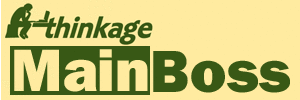Differences between MainBoss Basic and MainBoss
What's the difference between MainBoss and MainBoss Basic?
Administrative Differences
MainBoss Basic:
- Designed for small to mid-sized maintenance departments.
- Does not require sophisticated IT support.
- Single integrated software package
- Uses a modified Codebase database. Data can be exported from all or part of the database into a format suitable for Microsoft Access or Excel.
- Able to operate in English, French, Spanish and German.
- Only works in 32-bit mode (but will run on 64-bit versions of Windows).
- MainBoss Basic licenses cost less than MainBoss.
- MainBoss Basic is licensed by the "seat"; this means the number of people who can be using the software simultaneously.
MainBoss:
- Designed around Microsoft SQL and requires the ability to setup a Microsoft SQL Server. This provides robust protection of your maintenance data.
- MainBoss accesses its data using Microsoft SQL Server 2008 SP1 or later. SQL Server comes in a variety of versions in order to provide effective service, no matter how much data you have to handle. (There's even a free version for smaller sites.) SQL Server is also a known quantity to IT departments; you may already have it installed at your site for use with other software packages.
- MainBoss lets you use the web to access requests and work orders. Specifically, MainBoss makes it easy for you to set up your own web site where authorized users can submit work requests. The same web site can allow workers to see work orders and requests to which they have been assigned. This web site can be accessed by computers or by high-end mobile devices (e.g. an iPhone or BlackBerry).
- MainBoss has features aimed at operating in a paper-free environment. For example, security facilities make it possible for workers to sign on to MainBoss and see their own work orders without seeing anyone else's or seeing the costs of materials/labor. With MainBoss Basic, this isn't possible—you can't selectively restrict access to work orders, and if you give someone permission to see a work order, that person can also edit it.
- MainBoss imposes strict controls over accounting information—MainBoss Basic allowed you to "back-edit" costs, but MainBoss does not. (In MainBoss, you can add new entries to correct old ones, if necessary.) This means that MainBoss provides you with a clean audit trail of the sort usually required by accountants and auditors. Accounting information from MainBoss may be exported for use by custom-written user programs.
- MainBoss currently operates in English and Spanish.
- MainBoss works in 32-bit or 64-bit mode.
- MainBoss may make use of Microsoft's ClickOnce deployment.
- MainBoss is licensed by the number of users; this means the total number of people that are authorized to use MainBoss. More exactly, this means the total number of Windows login names that are authorized to start the MainBoss program.
MainBoss can import a large subset of data from MainBoss Basic databases. This makes it possible to migrate from MainBoss Basic to MainBoss. Note, however, that the migration process doesn't transfer all data—some Basic data structures just can't be translated directly into data structures. For this reason, migration is more than a simple upgrade; we strongly recommend that MainBoss users considering migration should contact MainBoss Support to discuss the process.
Technical Differences
The following points outline a few of the "fine-detail" differences between MainBoss and MainBoss Basic:
- MainBoss reports may be written in PDF or exported to Microsoft Excel. Reports can also be exported in XML. MainBoss offers much more sophisticated facilities for grouping and sorting data in reports.
- MainBoss has better facilities for organizing locations and units. In particular, a building might be a main location that is broken into a sublocation for each floor, and each floor might then be broken into further sublocations (one for each room on each floor). Similarly units may have subunits, so that an assembly line unit might be subdivided into a number of separate machine units.
- MainBoss has a unified Contacts list for all people you may wish to contact, including employees, suppliers, contractors, and anyone else whose contact information you wish to record.
-
People can be assigned to requests, work orders and purchase orders.
Being assigned to such a record can indicate that you have an interest in that record.
For example, workers might be assigned to the work order for any job they're expected to do.
Help-desk personnel might assign themselves to any request they create.
To help you keep track of assignments, the MainBoss control panel now has an Assigned to entry which lists requests, work orders and purchase orders to which you have been assigned. This is a quick way to find the records you're most likely to be interested in.
A variety of changes have been added in connection with assignments. For example, requests, work orders and purchase orders all have new Assignees sections to deal with assignments. -
MainBoss Basic and MainBoss have completely different approaches to security.
- MainBoss Basic has special internal user names and passwords. For each user, the administrator may specify which menus and menu items the person is permitted to use.
- MainBoss's security is based on your normal Windows login name. Each person may be assigned zero or more security roles; each role provides a unified group of permissions to the user. For example, someone with WorkOrderView role would be able to look at work orders but not modify them (unless the person had other security roles too). In this way, you can tailor a person's permissions to the job(s) they have to do.
- Unlike MainBoss Basic, you can have multiple labor costs for the same worker. For example, you can have one record for a worker's normal pay, and another record for time-and-a-half overtime pay. This makes it easier to track labor expenses correctly.
-
MainBoss has much more sophisticated facilities for dealing with work requests:
- MainBoss has much more sophisticated facilities for handling requests. For example, it's possible to have multiple requests associated with a single work order (which might happen if several people all report the same problem). It's also possible to have multiple work orders associated with a single request (which might happen, for example, if you make one work order that provides a quick short-term fix to a problem, and a second work order to put in a long-term fix when you have more time to do the job).
- Work requests can be marked as "In Progress". If you have the MainBoss Service module, this will automatically send email to requestors indicating that work on their requests has begun.
- MainBoss can handle e-mail messages in either text or HTML. (The comparable facility in MainBoss Basic only handles plain text.) Also, MainBoss supports more secure mail protocols, such as POP3 and IMAP4 with SSL.
- You can now track inventory in temporary storage locations. For example, if you transport materials to a work site, you can specify that the site is now a temporary storage location for the materials. This is useful for jobs that might last several days; you can keep track of what has and hasn't been moved to the work site yet.
- It's now easy to keep a set of standard tasks that can be used to make boiler-plate work orders. For example, you might create a task for a muffler change on a vehicle. Whenever a vehicle needs a muffler change, you can quickly create a full order from the existing task, thereby saving you the trouble of typing out full work instructions. Create a task for every job you do frequently, then use those tasks to create full work orders quickly.
- Almost every type of record has a Comments field that lets you record arbitrary information that might not be covered by other fields.
- In MainBoss Basic, generating planned maintenance work orders is a one-step process. If you make a mistake (such as asking for all work orders due in the next year, as opposed to the next week), you have no chance to reverse what you've done. MainBoss, however, uses a two-step process: a Generate phase (which determines which work orders should be generated) and a Commit phase (which actually creates the work orders). This gives you a chance to catch any mistakes before they're permanently committed.
-
When printing a work order, MainBoss offers several options
not found in MainBoss Basic:
- Suppress Costs: Prevents labor and material costs from being printed on the work order.
- Suppress Labor Duration Estimate: Prevents work time estimates from being printed on the work order.
- Include Unit Specifications and Attachments: Prints any specifications associated with the unit being serviced. Also displays names of attached files (though not their contents).
- Work orders let you record miscellaneous costs that aren't covered by labor or direct use of materials. This might include equipment rentals, or parking costs that a worker has to pay out of pocket during the course of a job.
- MainBoss allows you to have multiple windows open at once.
- MainBoss has much more sophisticated search and filter features for finding desired information.
-
MainBoss makes it possible to record and transmit various types of communications associated
with requests, work orders, and purchase orders.
In particular, maintenance personnel can add comments to requests, etc. which are then sent by e-mail
to all designated assignees.
Requestors can also supply additional information if maintenance personnel request it.
In this way, MainBoss can preserve a record of any back-and-forth associated with a request, work order or purchase order. This helps to track and clarify what actually happens during the course of a job or a purchase. - MainBoss lets you note any special status of a request, work order, or purchase order. For example, if a purchase order is waiting for management approval, or if a work order is waiting for parts or a building permit, you can record this information.
- MainBoss is licensed on a modular basis. You can pick the functionality you need, without getting any extras...but more functionality is ready when you are.
- MainBoss Basic tends to have a strict order in which things should be done—you have to create certain records before you start creating other (related) records. MainBoss allows more freedom; in particular, if you're working on creating a particular type of record, you can create other related records "on the fly" without having to quit working on the original record.
- MainBoss Basic has a clone operation which allows you to make duplicates of most record types. MainBoss does not have this feature.
You can obtain complete details about MainBoss Basic and MainBoss by checking out our online documentation pages. These show actual documentation for both software packages.




